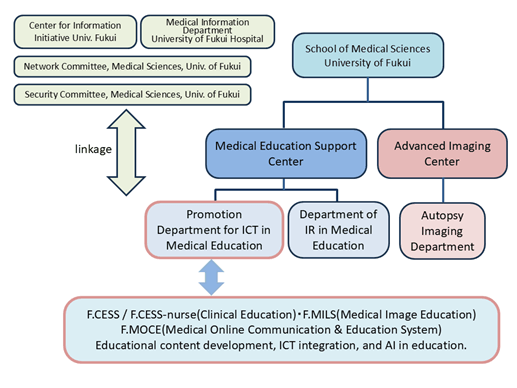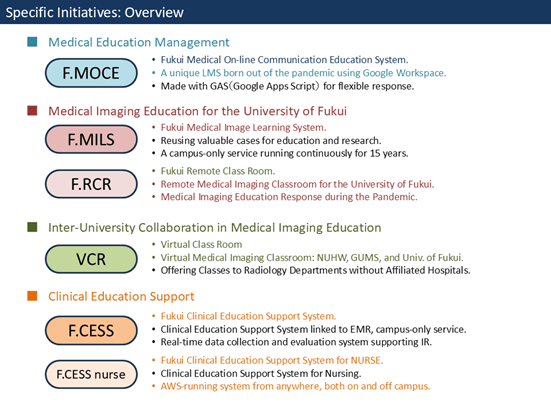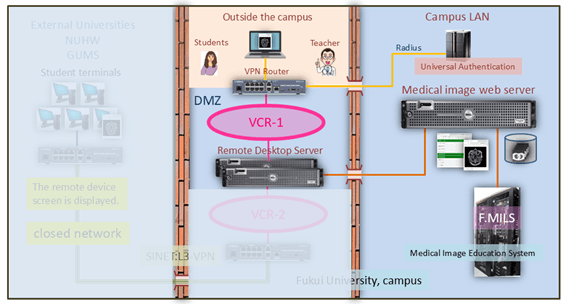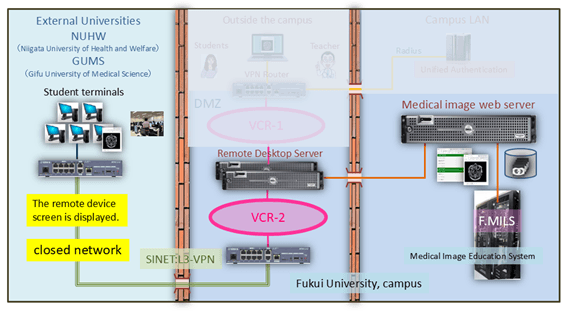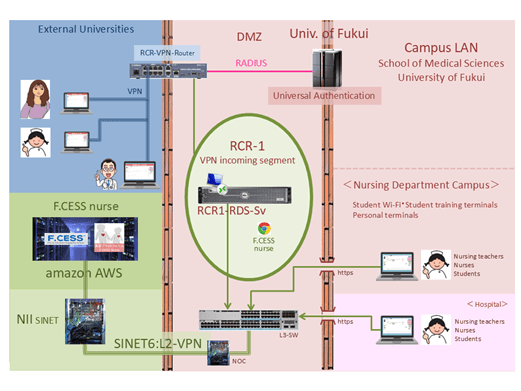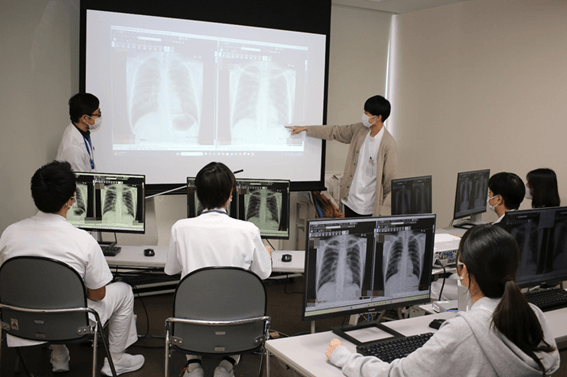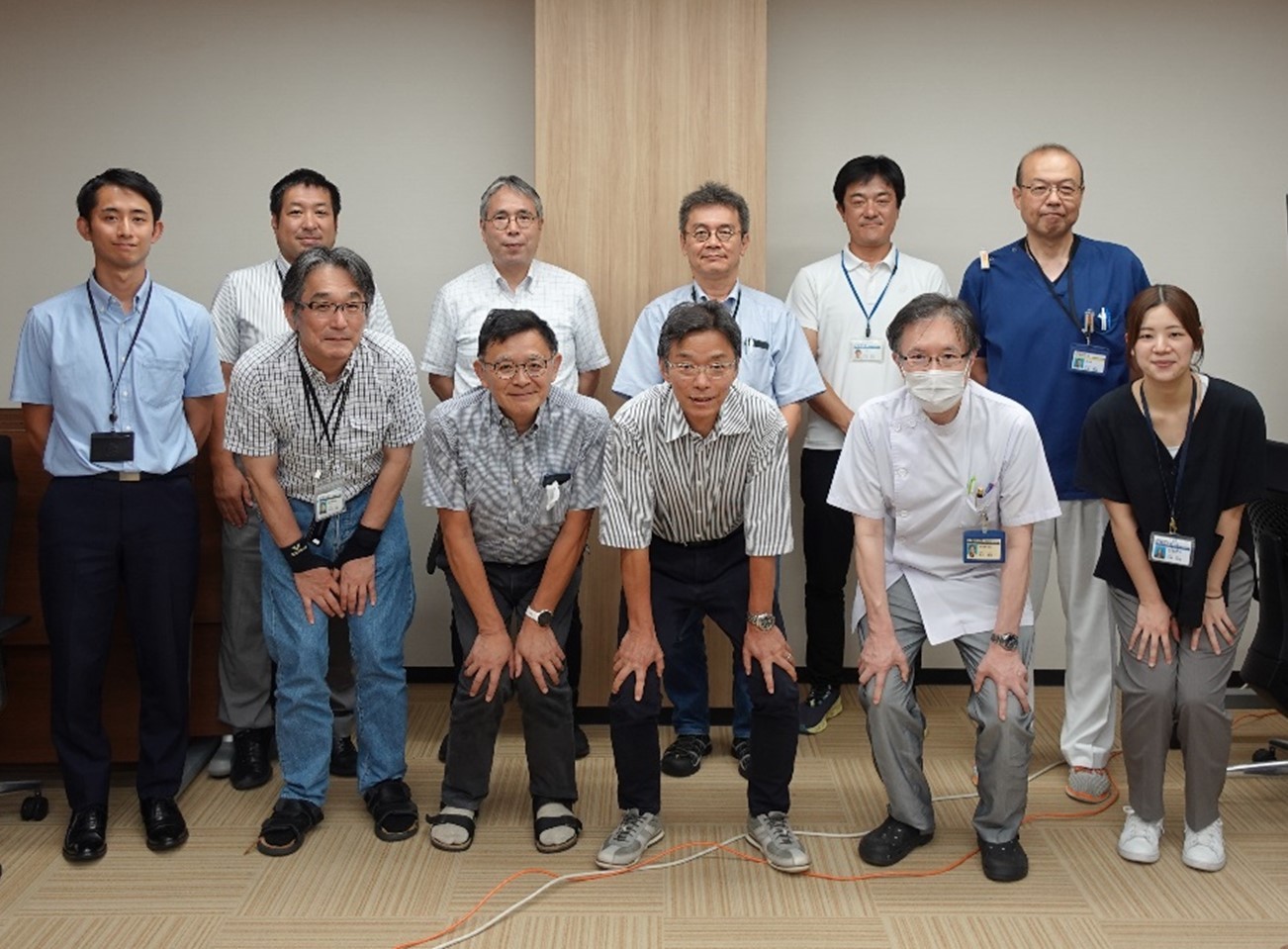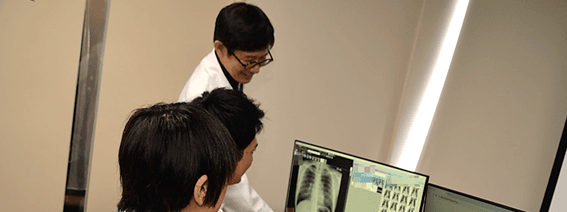
At the Forefront of ICT Use in Medical Education: Expanding Data Linkage and Educational Support Systems with SINET6
The Medical Education Support Center, University of Fukui, is deploying an advanced medical education support system leveraging the high-speed SINET6 network. In particular, it strives to realize effective medical education through our original systems such as the diagnostic imaging education system “F.MILS” as well as the clinical clerkship support systems “F.CESS” (for medical students) and “F.CESS nurse” (for nursing students). In this interview, we provide a detailed overview of the background behind the development of these systems, their implementation, and future prospects. (Interview date: September 13, 2024)
Please tell us about the organizational structure and goals of the University of Fukui Medical Education Support Center.
The University of Fukui Medical Education Support Center operates directly under the School of Medical Sciences as an organization that also includes the Department of Promotion Department for ICT in Medical Education. Its main goals are to inspect, evaluate, and improve education in general at the School of Medical Sciences, to develop and introduce new educational approaches, to implement educational IR in support of the planning of educational improvement work by collecting and analyzing information both inside and outside the university, and to implement education-related ICT.
In AY2024, the Educational System Division of the Advanced Imaging Center and the Clinical Education Support System Steering Committee, which is responsible for educational support of clinical training, were merged into the Promotion Department for ICT in Medical Education within the Medical Educational Support Center.
This provided us with a system that enables us to comprehensively promote content development, ICT education, and AI introduction and support, including the medical image learning system “F.MILS,” the remote medical imaging class “F.RCR,” and the clinical education support systems “F.CESS/F.CESS nurse.”
Please tell us specifically about your educational ICT initiatives.
I’ll introduce the university’s educational ICT initiatives. In terms of medical education management, we have developed our own LMS called “F.MOCE” (Fukui Medical Online Communication Education System). It provides online access to check the faculty and student apps online and supports student bulletin boards, attendance management, health checks, and dashboards as well as reinforcing the medical school curriculum. It uses Google Workspace and was made with Google Apps Script (GAS) by taking the concepts of simplicity and comprehensibility, so it facilitates flexible responses.
Moreover, “F.MILS” and “F.RCR” help with medical imaging education on campus. The Fukui Medical Image Learning System (F.MILS) was developed for the purpose of reusing valuable cases for education and research and has operated as a service restricted to the campus for more than 15 years. By integrating radiological images, virtual microscope images, multi-view anatomical images, and documents, medical images and data of cases with high educational value are converted into content that can be used and shared by students. “F.MILS” has functions to search for cases, classify them against curriculum items, export them, remove personal information, convert them to JPEG, and output them to an online server on the campus LAN.
“F.RCR” (Fukui Remote Class Room) is a remote medical imaging class service that lets you use the imaging education resources of “F.MILS,” which were restricted to the campus during the COVID-19 pandemic, also when you are off campus.
Moreover, there is a virtual medical imaging class called “VCR” (Virtual Class Room) that works as inter-university collaborative medical imaging education. We provide learning opportunities at medical universities that do not have affiliated hospitals, currently conducting collaboration among Niigata University of Health and Welfare, Gifu University of Medical Science, and the University of Fukui. Previously, a challenge existed in sharing images off-campus because of the need to protect personal information. We were able to create a system in consultation with the Department of Radiology and in compliance with regulations regarding personal information. As a result, it is now possible to view not only single images as previously found in textbooks but also serial tomographic images at high speed and in three dimensions, which has led to higher awareness among anatomy students. We believe that collaborating with other universities on this kind of system will help train radiographers better.
Lastly, there is the “F.CESS /F.CESS nurse” that we created in support of clinical practice. F.CESS or the Fukui Clinical Education Supporting System works in conjunction with electronic medical records to enable medical record communication and report submission, while faculty members can also give advice on changes and corrections and answer questions in a chat in real time. By preparing portfolios for individual student, it is possible to run the PDCA cycle based on changes and improvements from last year while taking a bird’s-eye view of the overall situation. These are real-time data collection and evaluation systems that distance themselves from conventional paper-based medical record work and supports educational IR. Development began in 2014, trial operation in 2017, actual operation in 2018, and a patent was obtained by the University of Fukui.
“F.CESS nurse” is an on-site training support system developed with an IT company in Fukui for the Collage of Nursing. It also supports the making of and teaching with relevant diagrams, which students used to spend a lot of time writing by hand during on-site training. Using SINET’s commercial cloud connection service lets you use the AWS-running system from anywhere, both on and off campus. This is being introduced not only at the University of Fukui but also at other universities.
Please tell us about your network environment for remote learning and inter-university collaboration.
To begin with, when faculty members and students access the remote medical imaging system “F.RCR” from off campus, they use a dedicated VPN router and verify their identity with a RADIUS server using the University of Fukui universal authentication system before entering the receiving segment. The remote desktop server is in the receiving segment and the DMZ, and from the DMZ, they enter the campus LAN through the firewall to access “F.MILS” and the online server.
Next, let us talk about VCR, a network for medical imaging education in collaboration with other universities. The student terminals at Niigata University of Health and Welfare and Gifu University of Medical Science connect to the remote desktop server from the receiving segment on the DMZ via SINET6’s L3VPN (L3VPN configured among the SINET routers in Niigata and Gifu and the SINET routers in Fukui). There is no individual user authentication, with seminar rooms at the other universities counting as one segment. Then, as before, you can access the shared image and online server on the campus LAN through the firewall.
Lastly, I’ll explain the network of the on-site practice support system “F.CESS nurse.” From off campus, you enter the receiving segment after completing universal authentication with RADIUS via the VPN router in the same way as with “F.RCR.” Then, from the remote desktop, the AWS server is accessed through the SINET6 cloud connection service (L2VPN is configured between the SINET router in Fukui and the nearest SINET router in AWS, directly connecting the University of Fukui and AWS) via the router for connecting to AWS. Moreover, campus LAN exercises, faculty members, and medical record terminals can also be accessed through the firewall via the AWS connection router. In this way, it’s configured so that it can be used “from anywhere.”
Let me ask you about your future prospects
Medical education is shifting to participatory clinical training, where students not only observe behind their supervisors but also participate in actual medical care. However, given the tight schedules of clinicians, there are dozens of medical students working in each department simultaneously, making participatory clinical training challenging. The university has been working to develop an LMS that minimizes the increase in the burden on clinicians through DX.
We are also working on reforming the way doctors work using AI. For example, we have an AI-powered speech recognition and summarization tool. In the past, doctors wrote medical records from memory after a medical examination, but the AI camera recognizes the speaker, automatically transcribes and summarizes speech, and attaches that to the electronic medical record after ensuring confidentiality via API.
Otherwise, we are working on developing AI-simulated patients using chatbots to practice medical interviews, strengthening the mobility of our multi-viewpoint autopsy system, and extracting the X-ray interpretation know-how left behind by skilled doctors into image and linguistic information so that LLMs can learn from them to finetune and become useful for education.
Additionally, the university’s electronic medical record system is operated using a cloud. For the future, I hope we can consider using SINET’s L2VPN service to support a multi-cloud system.
Lastly, because of his enthusiasm for the use of ICT, the former Dean of the School of Medical Sciences said that ICT is a human network and connections with people. ICT is a tool, and we want to appraise its completeness in terms of whether we can glimpse some humanity in there. Using educational ICT, we want to provide education that helps students become doctors and nurses who can earn the affection of their patients.

